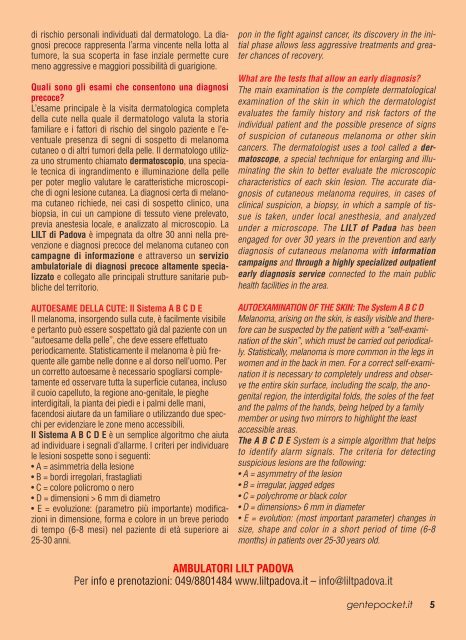You also want an ePaper? Increase the reach of your titles
YUMPU automatically turns print PDFs into web optimized ePapers that Google loves.
di rischio personali individuati dal dermatologo. La dia<br />
gnosi precoce rappresenta l’arma vincente nella lotta al<br />
tumore, la sua scoperta in fase inziale permette cure<br />
meno aggressive e maggiori possibilità di guarigione.<br />
Quali sono gli esami che consentono una diagnosi<br />
precoce?<br />
L’esame principale è la visita dermatologica completa<br />
della cute nella quale il dermatologo valuta la storia<br />
familiare e i fattori di rischio del singolo paziente e l’e<br />
ventuale presenza di segni di sospetto di melanoma<br />
cutaneo o di altri tumori della pelle. Il dermatologo utiliz<br />
za uno strumento chiamato dermatoscopio, una specia<br />
le tecnica di ingrandimento e illuminazione della pelle<br />
per poter meglio valutare le caratteristiche microscopi<br />
che di ogni lesione cutanea. La diagnosi certa di melano<br />
ma cutaneo richiede, nei casi di sospetto clinico, una<br />
biopsia, in cui un campione di tessuto viene prelevato,<br />
previa anestesia locale, e analizzato al microscopio. La<br />
LILT di Padova è impegnata da oltre 30 anni nella pre<br />
venzione e diagnosi precoce del melanoma cutaneo con<br />
campagne di informazione e attraverso un servizio<br />
ambulatoriale di diagnosi precoce altamente specializzato<br />
e collegato alle principali strutture sanitarie pub<br />
bliche del territorio.<br />
AUTOESAME DELLA CUTE: Il Sistema A B C D E<br />
Il melanoma, insorgendo sulla cute, è facilmente visibile<br />
e pertanto può essere sospettato già dal paziente con un<br />
“autoesame della pelle”, che deve essere effettuato<br />
periodicamente. Statisticamente il melanoma è più fre<br />
quente alle gambe nelle donne e al dorso nell’uomo. Per<br />
un corretto autoesame è necessario spogliarsi comple<br />
tamente ed osservare tutta la superficie cutanea, incluso<br />
il cuoio capelluto, la regione ano-genitale, le pieghe<br />
interdigitali, la pianta dei piedi e i palmi delle mani,<br />
facendosi aiutare da un familiare o utilizzando due spec<br />
chi per evidenziare le zone meno accessibili.<br />
Il Sistema A B C D E è un semplice algoritmo che aiuta<br />
ad individuare i segnali d’allarme. I criteri per individuare<br />
le lesioni sospette sono i seguenti:<br />
• A = asimmetria della lesione<br />
• B = bordi irregolari, frastagliati<br />
• C = colore policromo o nero<br />
• D = dimensioni > 6 mm di diametro<br />
• E = evoluzione: (parametro più importante) modifica<br />
zioni in dimensione, forma e colore in un breve periodo<br />
di tempo (6-8 mesi) nel paziente di età superiore ai<br />
25-30 anni.<br />
pon in the fight against cancer, its discovery in the initial<br />
phase allows less aggressive treatments and greater<br />
chances of recovery.<br />
What are the tests that allow an early diagnosis?<br />
The main examination is the complete dermatological<br />
examination of the skin in which the dermatologist<br />
evaluates the family history and risk factors of the<br />
individual patient and the possible presence of signs<br />
of suspicion of cutaneous melanoma or other skin<br />
cancers. The dermatologist uses a tool called a dermatoscope,<br />
a special technique for enlarging and illuminating<br />
the skin to better evaluate the microscopic<br />
characteristics of each skin lesion. The accurate diagnosis<br />
of cutaneous melanoma requires, in cases of<br />
clinical suspicion, a biopsy, in which a sample of tissue<br />
is taken, under local anesthesia, and analyzed<br />
under a microscope. The LILT of Padua has been<br />
engaged for over 30 years in the prevention and early<br />
diagnosis of cutaneous melanoma with information<br />
campaigns and through a highly specialized outpatient<br />
early diagnosis service connected to the main public<br />
health facilities in the area.<br />
AUTOEXAMINATION OF THE SKIN: The System A B C D<br />
Melanoma, arising on the skin, is easily visible and therefore<br />
can be suspected by the patient with a “self-examination<br />
of the skin”, which must be carried out periodically.<br />
Statistically, melanoma is more common in the legs in<br />
women and in the back in men. For a correct self-examination<br />
it is necessary to completely undress and observe<br />
the entire skin surface, including the scalp, the anogenital<br />
region, the interdigital folds, the soles of the feet<br />
and the palms of the hands, being helped by a family<br />
member or using two mirrors to highlight the least<br />
accessible areas.<br />
The A B C D E System is a simple algorithm that helps<br />
to identify alarm signals. The criteria for detecting<br />
suspicious lesions are the following:<br />
• A = asymmetry of the lesion<br />
• B = irregular, jagged edges<br />
• C = polychrome or black color<br />
• D = dimensions> 6 mm in diameter<br />
• E = evolution: (most important parameter) changes in<br />
size, shape and color in a short period of time (6-8<br />
months) in patients over 25-30 years old.<br />
AMBULATORI LILT PADOVA<br />
Per info e prenotazioni: 049/8801484 www.liltpadova.it – info@liltpadova.it<br />
gentepocket.it 5



